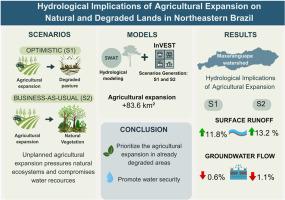巴西东北部自然和退化土地上农业扩张的水文影响
IF 1.5
4区 地球科学
Q3 GEOSCIENCES, MULTIDISCIPLINARY
引用次数: 0
摘要
无计划的农业扩张给自然生态系统带来压力,并危害水资源。在巴西,尽管存在大面积退化地区,但农业增长继续威胁着自然生态系统。本研究利用模型分析了巴西东北部Maxaranguape流域两种土地利用和土地覆盖(LULC)变化情景下农业扩张的水文影响:一种乐观情景(S1),农业取代退化的牧场;另一种一切照旧情景(S2),农业扩张侵蚀自然植被。我们根据2000年至2020年观察到的趋势预测了到2034年的农业扩张,这表明平均每年增加5.8平方公里。“一切照旧”情景(S2)的水文影响更为明显:S1和S2的地表径流分别增加11.8%和13.2%,而地下水流量分别减少0.6%和1.1%。这些变化导致S1最小流量(Qmin)减少2.4%,S2减少5.2%,S1最大流量(Qmax)增加4.4%,S2最大流量增加2.7%。S2下Qmin的更大幅度下降凸显了对水资源供应的更严重影响——这是巴西东北部等干旱易发地区尤为严重的问题。这些发现强调了优先考虑农业扩张而不是退化的牧场而不是自然生态系统的重要性,因为这种方法有助于防止进一步的森林砍伐,同时促进长期的水安全。本文章由计算机程序翻译,如有差异,请以英文原文为准。

Hydrological implications of agricultural expansion on natural and degraded lands in Northeastern Brazil
Unplanned agricultural expansion puts pressure on natural ecosystems and harms water resources. In Brazil, agricultural growth continues to threaten natural ecosystems despite the availability of extensive degraded areas. This study examines the hydrological impacts of agricultural expansion using modelling under two land use and land cover (LULC) change scenarios in the Maxaranguape watershed, in Northeastern Brazil: an Optimistic scenario (S1), where agriculture replaces degraded pasturelands, and a Business-as-usual scenario (S2), where expansion encroaches upon natural vegetation. We projected agricultural expansion through 2034 based on the trend observed between 2000 and 2020, which showed an average increase of 5.8 km2 per year. The Business-as-Usual scenario (S2) resulted in more pronounced hydrological impacts: surface runoff increased by 11.8 % in S1 and 13.2 % in S2, while groundwater flow decreased by 0.6 % and 1.1 %, respectively. These changes led to reductions in minimum streamflow (Qmin) of up to 2.4 % in S1 and 5.2 % in S2, and increases in maximum streamflow (Qmax) of up to 4.4 % in S1 and 2.7 % in S2. The greater decline in Qmin under S2 highlights a more severe impact on water availability—an especially critical concern in drought-prone regions like Northeastern Brazil. These findings underscore the importance of prioritizing agricultural expansion over degraded pasturelands rather than natural ecosystems, as this approach helps prevent further deforestation while promoting long-term water security.
求助全文
通过发布文献求助,成功后即可免费获取论文全文。
去求助
来源期刊

Journal of South American Earth Sciences
地学-地球科学综合
CiteScore
3.70
自引率
22.20%
发文量
364
审稿时长
6-12 weeks
期刊介绍:
Papers must have a regional appeal and should present work of more than local significance. Research papers dealing with the regional geology of South American cratons and mobile belts, within the following research fields:
-Economic geology, metallogenesis and hydrocarbon genesis and reservoirs.
-Geophysics, geochemistry, volcanology, igneous and metamorphic petrology.
-Tectonics, neo- and seismotectonics and geodynamic modeling.
-Geomorphology, geological hazards, environmental geology, climate change in America and Antarctica, and soil research.
-Stratigraphy, sedimentology, structure and basin evolution.
-Paleontology, paleoecology, paleoclimatology and Quaternary geology.
New developments in already established regional projects and new initiatives dealing with the geology of the continent will be summarized and presented on a regular basis. Short notes, discussions, book reviews and conference and workshop reports will also be included when relevant.
 求助内容:
求助内容: 应助结果提醒方式:
应助结果提醒方式:


